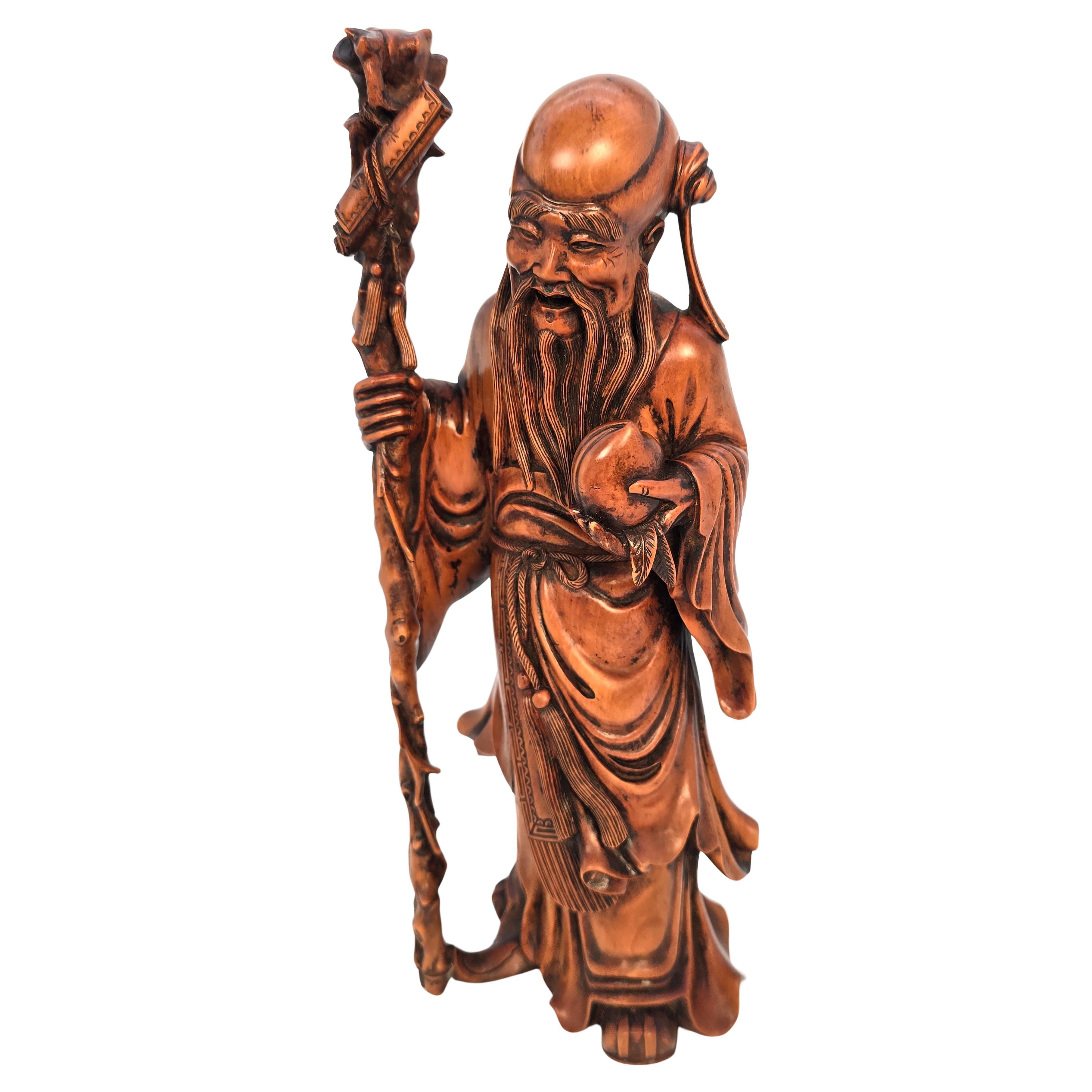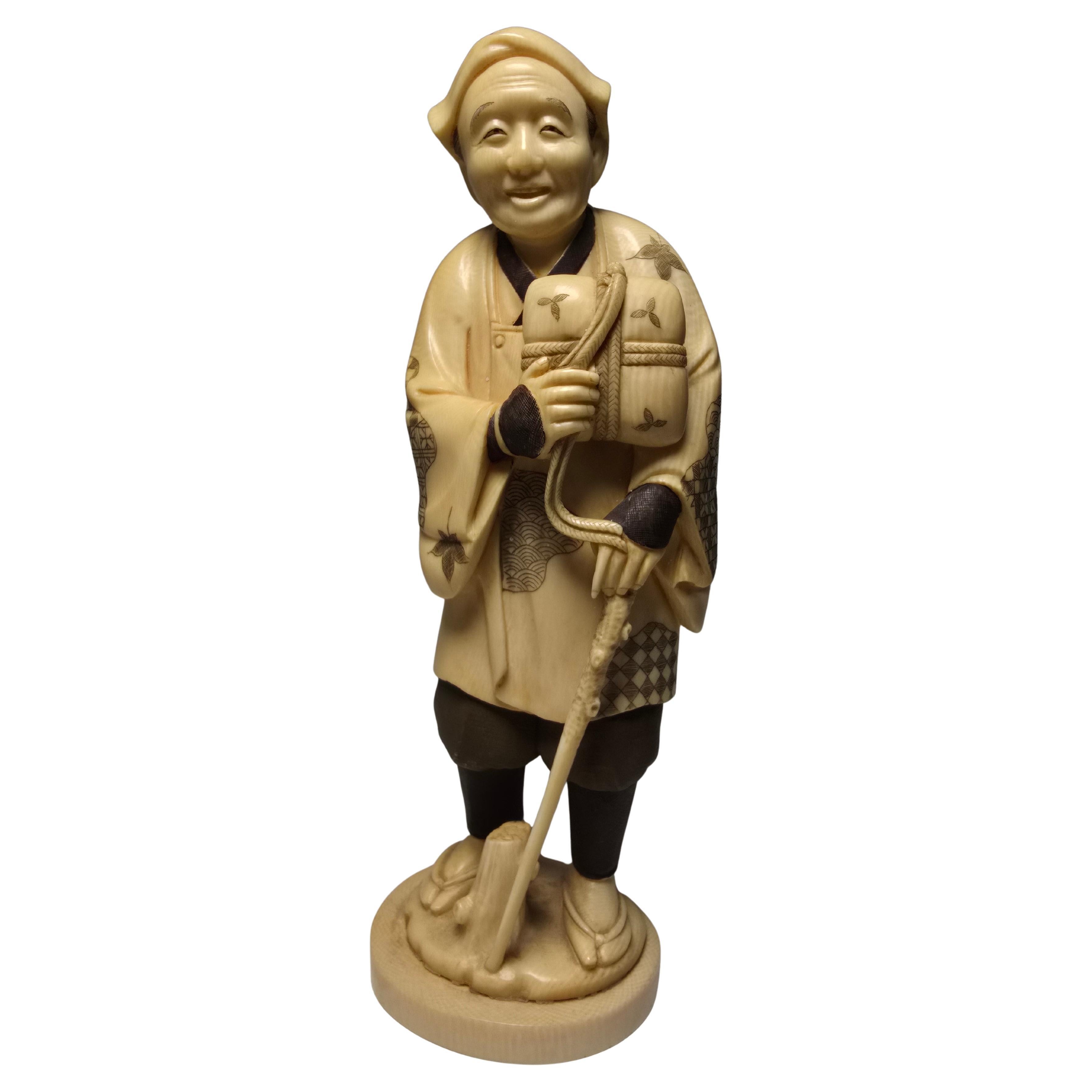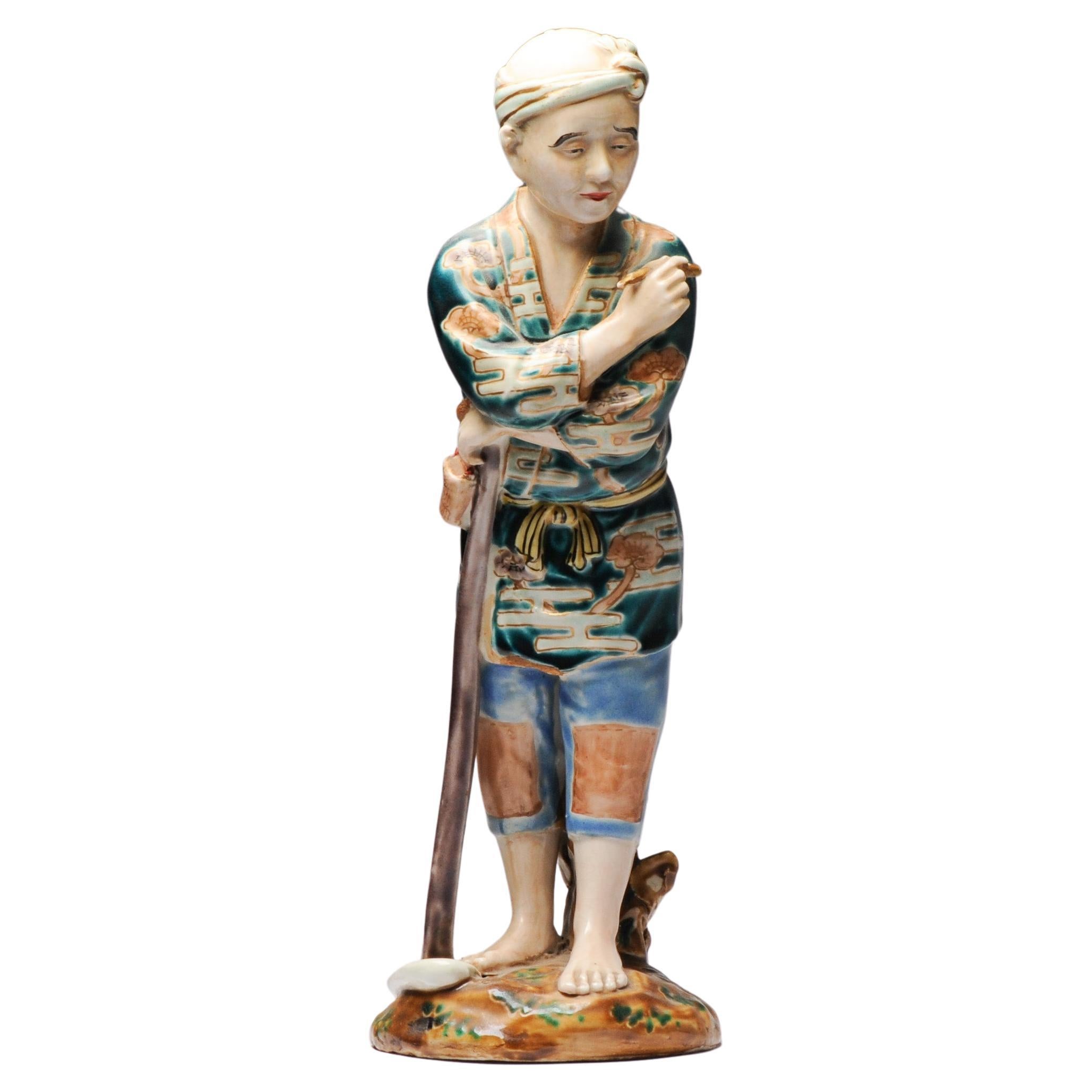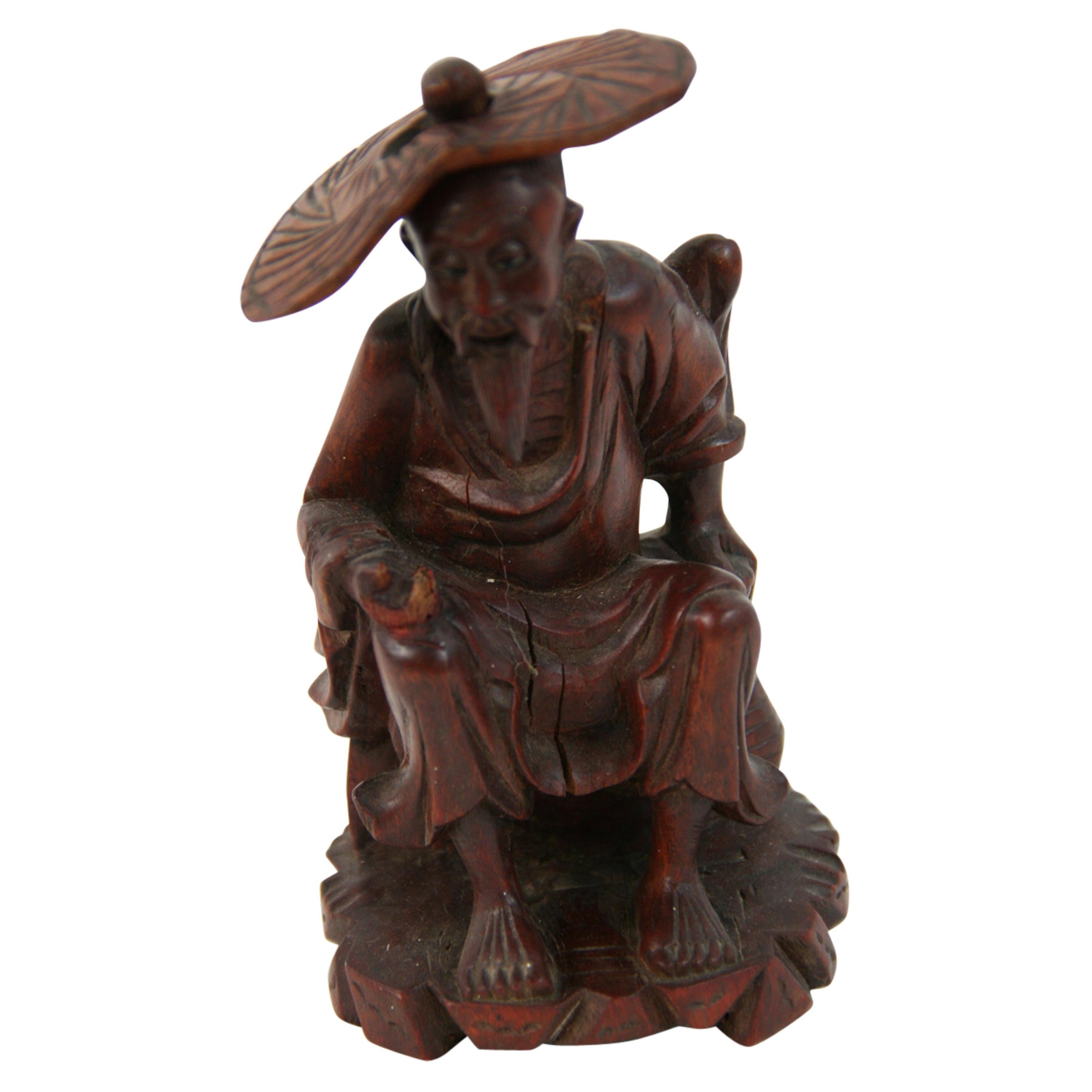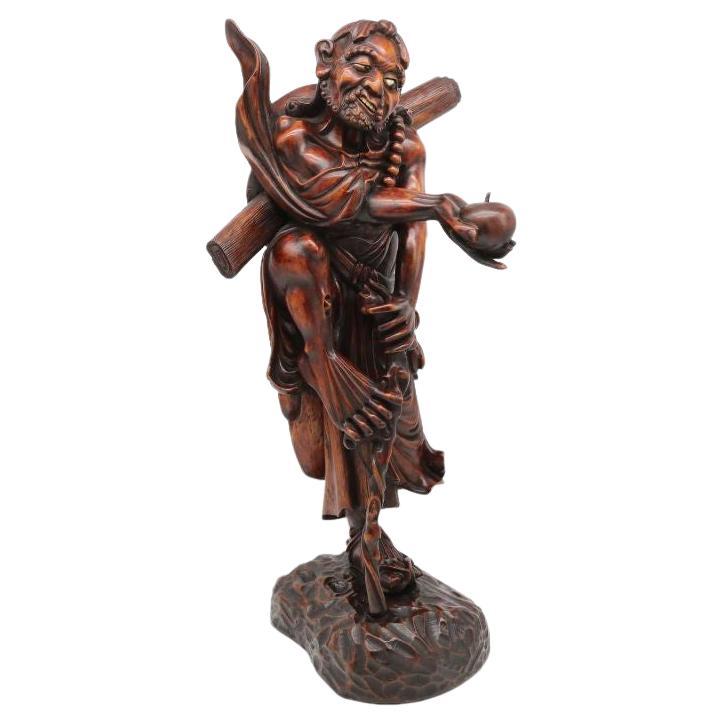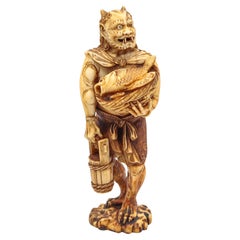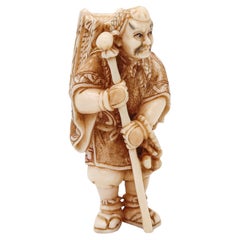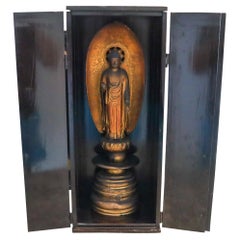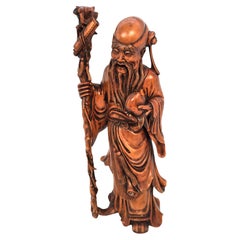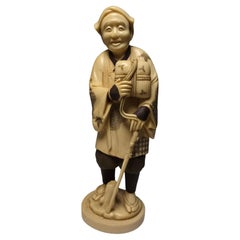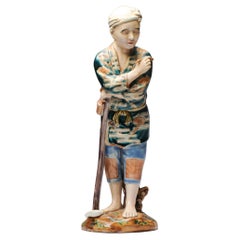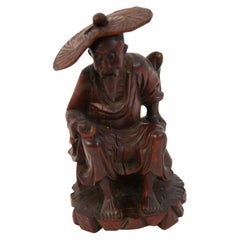Items Similar to JAPAN 1890 Meiji Carved Figure of Fortune God Daikoku As a Farmer With Coins
Want more images or videos?
Request additional images or videos from the seller
1 of 12
JAPAN 1890 Meiji Carved Figure of Fortune God Daikoku As a Farmer With Coins
$4,985
£3,811.30
€4,389.85
CA$6,985.51
A$7,798.67
CHF 4,086.39
MX$95,463.36
NOK 51,897.13
SEK 48,932.41
DKK 32,761.87
About the Item
A Japanese carved sculpture of Daikoku.
Magnificent sculpture of the god of the fortune Daikoku WITH OVER 100 YEARS OLD, created in Japan during the Meiji period, circa 1890. The carving depicts the Japanese god of good fortune, Daikoku is personified as a farmer holding a hoe with a clay jar full of ancient Koban gold coins at his feet. The carving is magnificent, extremely well detailed and proportionate, showing the farmer with outstanding attires. The level of detail achieved is shown in all parts of this sculpture, such as her hands, her sandals, and her happy facial expression. The figure is stained with ochre and white tinted inks and the coins remain with the original 24kt gilding.
Daikoku
Daikoku or Daikokuten literally means “Great Black Deva” God of Earth, Agriculture, Rice, Farmers, the Kitchen, & Wealth. Is one of the Seven Lucky Gods in Japanese mythology who bring prosperity and fortune to people throughout Japan. As the god of luck and fortune-seeking, he is an important household deity also known as the god of five cereals. Those bold enough to make their own fortunes receive Daikokuten blessings.
Koban Gold Coins
The at the feet of this farmer are gold Koban coins struck during the Tempo Era of Japan, between 1830-1844. The Japanese economy before the mid-19th century was based largely on rice. The standard unit of measure was the koku, the amount of rice needed to feed one person for one year. Farmers made their tax payments of rice which eventually made its way into the coffers of the central government; and similarly, vassals were annually paid a specified koku of rice. The Portuguese who came to Japan in the 1550s, however, preferred gold to rice; and the koban, which was equal to three kokus of rice, became the coin of choice in foreign trade.
The Meiji Period
This is an era of Japanese history that extended from October 23, 1868, to July 30, 1912.The Meiji era was the first half of the Empire of Japan, when the Japanese people moved from being an isolated feudal society at risk of colonization by Western powers to the new paradigm of a modern, industrialized nation state and emergent great power, influenced by Western scientific, technological, philosophical, political, legal, and aesthetic ideas. As a result of such wholesale adoption of radically different ideas, the changes to Japan were profound, and affected its social structure, internal politics, economy, military, and foreign relations. The period corresponded to the reign of Emperor Meiji. It was preceded by the Keio era and was succeeded by the Taishō era, upon the accession of Emperor Taishō.
Weight: 1,460 Grams, (1.46 Kg).
Measurements: 185 mm by 106 mm by 117 mm (7.25 x 4.18 x 4.62 Inches).
Signature: Inlaid at the base with an oval red lacquer cartouche bearing the artist's mark and engraved with a maple leaf.
Note: This piece is over 100 years old, and we can provide provenance.
Condition: The overall condition of this sculpture is excellent restored. Beside the little normal wear, all parts are secured in the settings. This piece has been carefully inspected to guarantee the condition and the authenticity.
INVENTORY REF: D010524MMRE/.6712
- Dimensions:Height: 7.25 in (18.42 cm)Width: 4.18 in (10.62 cm)Depth: 4.62 in (11.74 cm)
- Style:Meiji (Of the Period)
- Materials and Techniques:
- Place of Origin:
- Period:
- Date of Manufacture:1890
- Condition:Refinished. Wear consistent with age and use. The overall condition of this sculpture is excellent restored. Beside the little normal wear, all parts are secured in the settings. This piece has been carefully inspected to guarantee the condition and the authenticity.
- Seller Location:Miami, FL
- Reference Number:Seller: D010524MMRE/.67121stDibs: LU8303243241772
About the Seller
5.0
Gold Seller
Premium sellers maintaining a 4.3+ rating and 24-hour response times
1stDibs seller since 2023
206 sales on 1stDibs
Typical response time: 3 hours
- ShippingRetrieving quote...Shipping from: Miami, FL
- Return Policy
Authenticity Guarantee
In the unlikely event there’s an issue with an item’s authenticity, contact us within 1 year for a full refund. DetailsMoney-Back Guarantee
If your item is not as described, is damaged in transit, or does not arrive, contact us within 7 days for a full refund. Details24-Hour Cancellation
You have a 24-hour grace period in which to reconsider your purchase, with no questions asked.Vetted Professional Sellers
Our world-class sellers must adhere to strict standards for service and quality, maintaining the integrity of our listings.Price-Match Guarantee
If you find that a seller listed the same item for a lower price elsewhere, we’ll match it.Trusted Global Delivery
Our best-in-class carrier network provides specialized shipping options worldwide, including custom delivery.More From This Seller
View AllJAPAN 1880 Meiji Signed Okimono Sculpture Of ONI Demon Holding Basket With Fish
Located in Miami, FL
Meiji period okimono sculpture of Oni.
This is an exceptional okimono sculpture created in the late 19th century during the imperial Japan in the Meiji era period, back in 1880. The...
Category
Antique 1880s Japanese Meiji Sculptures and Carvings
Materials
Glass
$2,200 Sale Price
20% Off
JAPAN 1890 Meiji Sculptural Polychromate Netsuke Of a Yamabushi
Located in Miami, FL
Japanese Meiji period netsuke. of a Yamabushi.
This is an exceedingly beautiful and intricate carved netsuke, created during the imperial Japan in the Meiji period, back in he 1890....
Category
Antique 1890s Japanese Meiji Sculptures and Carvings
Materials
Bone
CHINA REPUBLICAN 20th Century Buddha Statue In Porcelain Zeng Long Sheng Mark
Located in Miami, FL
A China republic seated Buddha in porcelain.
This is a beautiful antique devotive figure of a seated happy Buddha created in the China Republic back in the early 20th-century, circa...
Category
Vintage 1920s Chinese Chinese Export Sculptures and Carvings
Materials
Enamel
JAPAN 1810 Edo Period Large Butsudan Home Altar With Amida Nyorai In Wood
Located in Miami, FL
Large butsudan home altar with Amida Nyorai figure Edo Period (1600-1868)
This is a beautiful Japanese wooden statue of standing Amida Nyorai Buddha, from the Edo period (1600-1868)...
Category
Antique 1810s Japanese Edo Sculptures and Carvings
Materials
Gold, Brass
JAPAN Edo Period 1825 Seated Buddha Sculpture In Solid Gilded Carved Wood
Located in Miami, FL
A seated Buddha sculpture in gilt carved wood from the Edo Period.
This is a superbly refined carved wooden figure of a seated Buddha with fabulous pure gold gilt. The sculpture has...
Category
Antique 1820s Japanese Edo Sculptures and Carvings
Materials
Gold
JAPAN Edo Period 1750 Amida Nyorai Buddha Sculpture In Gilt Carved Wood
Located in Miami, FL
An Amida Nyorai Sculpture In Gilt Carved Wood from the Edo Period.
This is a superbly refined carved wooden figure of Amida Nyorai (Amitabha), the Buddha of Infinite Light, with fab...
Category
Antique 1750s Japanese Edo Sculptures and Carvings
Materials
Gold, Bronze, Gold Leaf
You May Also Like
Japanese Okimono of Fukurokuju, the god of wealth and happiness, Meiji period
Located in Central England, GB
This exceptional Japanese Meiji period okimono depicts Fukurokuju, the lucky god of wealth and happiness.
The figure is very finely carved from a single piece of dense tightly graine...
Category
Early 20th Century Japanese Meiji Figurative Sculptures
Materials
Wood
Elegant Japanese Sculpture from Early 1900s
Located in Madrid, ES
Step into the charm of early 20th century Japan with this exquisite sculpture, a true testament to the artistry and craftsmanship of the era. This elegant piece captures the essence ...
Category
Vintage 1910s Figurative Sculptures
Materials
Bone
Large Antique 19th-20th C Meiji Japanese Kutani Statue of a Man, Figure
Located in Amsterdam, Noord Holland
Description
A Japanese Kutani statue, Meiji period
Unmarked
Condition
Overall Condition small piece missing of the artifact held by the figure...
Category
Antique 19th Century Japanese Meiji Ceramics
Materials
Porcelain
$1,132 Sale Price
20% Off
Chinese Sculpture Hand Carved Farmer
Located in Douglas Manor, NY
8-163 small hand carved figure of a peasant with a removable straw hat. circa 1920-30's.
Category
Vintage 1920s Chinese Sculptures and Carvings
Materials
Fruitwood
Vintage Carved Wood Statue of the God Fukurokuju C1930
Located in Big Flats, NY
Vintage Asian Carved Wood Statue of the God Fukurokuju C1930
Measures - 19.25"h x 5"w x 4"d
Category
Early 20th Century Sculptures and Carvings
Materials
Wood
$360 Sale Price
20% Off
Late 19th Century Japanese Carved Hardwood Okimono of a Man, circa 1890
Located in Central England, GB
Late 19th C Japanese carved hardwood okimono of a man, circa 1890
This top quality and most impressive large scale Japanese carved hardwood okimono superbly depicts a characterful study of a delightfully crafty looking man. He is dressed simply in a robe. On his back, he has a rolled woven mat for resting and a turtle shell sun hat hangs below. On his side hanging from his waist sash, there is a simple hand fan made from woven palm leaves and around his neck, he is wearing a string of very large beads. This unfortunate character is on a journey and he seems to have lost or broken one sandal. His foot is sore and he is resting it on his gnarly walking stick. He has one arm outstretched and is holding out a large piece of fresh fruit as an offering perhaps to barter for new sandals...
Category
Antique 19th Century Japanese Figurative Sculptures
Materials
Hardwood
